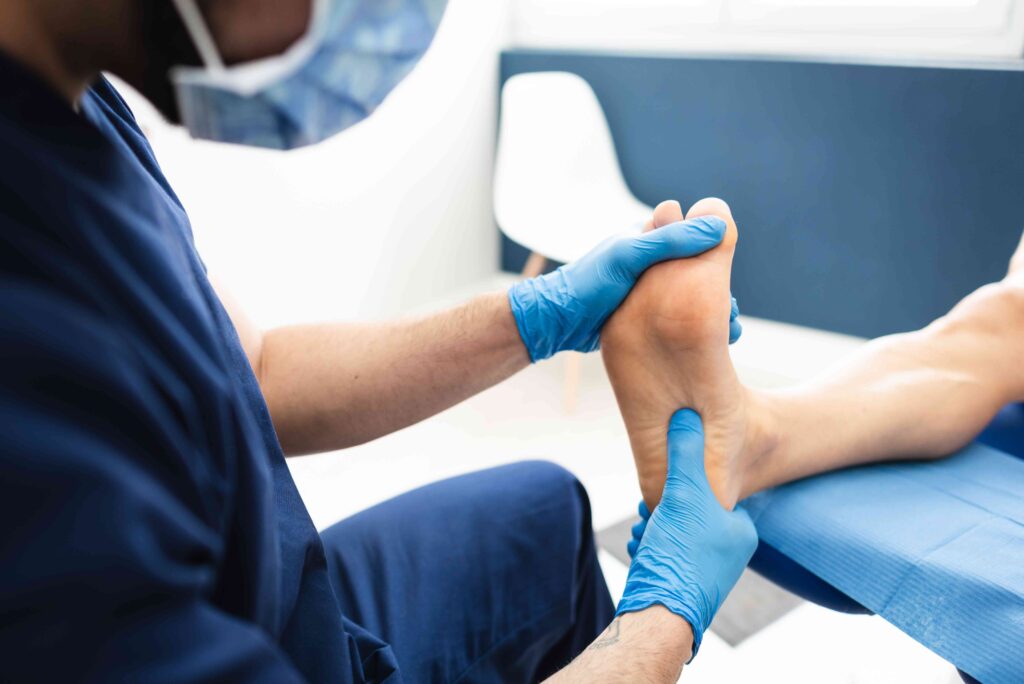:max_bytes(150000):strip_icc():format(jpeg)/Health-GettyImages-1324246981-7ee2e46d4c624b2582e139d1c4807603.jpg)
Fibromas are benign (noncancerous) tumors made of fibrous connective tissues—tissue made of tough protein fibers that protect and support muscles, bones, organs, and other body tissues.
Some fibromas, such as those on the skin or feet, may appear as a firm lump on or under the skin. Most people with fibromas experience no symptoms, but some may experience discomfort, pain, tenderness, or itching.
Most fibromas are harmless and do not require treatment. Medical procedures and surgery are available for safe fibroma removal for symptomatic or bothersome fibromas.
There are many types of fibromas. Their classification depends on which part of the body they develop and their characteristics. Common types include:
- Plantar fibroma: This small, slow-growing fibroma develops on the foot’s arch, between the heel and the fat pad beneath the toes.
- Oral fibroma: Also known as irritation or traumatic fibromas, oral fibromas develop inside the mouth, on the cheek lining, tongue, or inner lips.
- Dermatofibroma: These smooth, solid nodules (bumps) that may appear pink, brown, reddish, or skin-colored can commonly develop on the arms and legs.
- Angiofibroma: Made of blood vessels and fibrous connective tissue, these are small, red bumps that typically appear on the face, especially the cheeks and nose.
- Uterine fibroids: These noncancerous tumors grow within the wall of the uterus, sometimes causing heavy bleeding or pelvic pain.
- Nonossifying fibroma: This benign bone tumor, which is common in children and people under age 20, usually develops on a leg bone (e.g., the femur).
While most fibromas go unnoticed, all types may cause symptoms such as:
- Lumps or bumps: Depending on the location of the fibroma, you may spot a noticeable lump or bump on or under the skin. Dermatofibromas are visible bumps on the skin.
- Pain: Fibromas may cause tenderness, pain, or discomfort, especially if they press on nerves or irritate surrounding tissues. Plantar fibromas may cause pain when walking, and people with nonossifying fibromas may experience pain in the affected leg during physical activities.
- Bleeding: Certain fibromas, such as dermatofibromas, may bleed when picked at or due to physical trauma (e.g., a blow to the face). Uterine fibroids can cause uterine bleeding between menstrual cycles and heavy menstrual bleeding.
Depending on the fibroma’s size and location, the symptoms may be more noticeable. More specific symptoms you experience can depend on the fibroma type.
Plantar Fibroma Symptoms
Plantar fibromas develop on the arch of the foot and may cause pain when pressure is placed on the fibroma—such as when walking or wearing shoes. The lump can grow over time.
Oral Fibroma Symptoms
Oral fibromas can cause a small, firm lump to develop in the mouth. The lump may cause soreness, especially if you accidentally bite or rub your teeth against it.
Dermatofibroma Symptoms
A dermatofibroma may be a small or large lump on the skin. The middle may be indented, resembling a dimple. The discolored bump can be tender to the touch. It may also be itchy.
Angiofibroma Symptoms
These discolored bumps or spots on the face are usually on the cheeks and nose. When a large angiofibroma is located within the nasal cavity, it may obstruct your airway and make it hard for you to breathe.
Uterine Fibroid Symptoms
Uterine fibroids that grow within the walls of the uterus can cause symptoms such as:
- Heavy menstrual bleeding
- Pelvic pain
- Breakthrough bleeding, which is bleeding between periods
- Pain or pressure in the lower abdomen
- Painful sex
- Frequent urination due to added pressure on the bladder
Nonossifying Fibroma Symptoms
Nonossifying fibromas often cause no symptoms. When symptoms develop, they may include:
- Pain in the affected bone during physical activity
- Swelling and tenderness on the skin covering the affected bone
- Constant dull ache in the affected leg, even when resting
Fibromas develop due to an overgrowth of fibrous connective tissue. The exact cause of fibromas is not fully understood. Several factors may contribute to fibroma development, including:
- Genetics: Some fibromas are associated with inherited genetic conditions that increase the likelihood of developing growths (e.g., Gardner syndrome).
- Trauma or irritation: Repeated stress or injury to a part of the body, such as the feet or mouth, can trigger the formation of fibromas.
- Hormones: Female sex hormones, including estrogen and progesterone, play a role in the development of uterine fibroids.
Some fibromas may develop due to uncontrollable cell division. Cells in your body constantly grow and divide, forming new cells. As new cells form, old cells die. Fibromas may develop when new cells form, but old cells don’t die. The new, extra cells continue to divide and can form a fibroma.
Risk Factors
Anyone can develop fibromas, though certain risk factors can increase the likelihood of developing one or more.
One risk factor is genetics. A family history of fibromas or related genetic conditions can increase the possibility of developing fibromas.
Another risk factor is age. While fibromas can occur at any age, some types are more frequent during specific life stages. Nonossifying fibromas are most common in people aged 20 or younger, while dermatofibromas are most common in women aged 20-50.
Diagnosing a fibroma involves a physical examination and imaging tests. Your healthcare provider will also likely ask about your symptoms and review your personal and family medical history.
During the physical exam, your healthcare provider will feel for lumps or masses in the area of the suspected fibroma.
Your healthcare provider may order imaging scans and other diagnostic tests to rule out other possible causes of your symptoms, confirm the presence of a fibroma, and pinpoint its exact size and location. These tests may include:
- Ultrasound: Uses sound waves to create detailed images of structures within the body, helping visualize and measure fibromas
- X-ray: Takes detailed pictures of dense structures in the body, including bones, to help diagnose nonossifying fibromas
- Computed tomography (CT) scan: Creates detailed cross-sectional 3D images of internal organs, soft tissues, and bones to help differentiate fibromas from other growths
- Magnetic resonance imaging (MRI) scan: Provides highly detailed images of soft tissues and bones to help distinguish fibromas from other tumors
- Biopsy: A small tissue sample from a fibroma that is sent to the lab for testing to confirm the diagnosis and rule out other possible causes
In many cases, especially with asymptomatic fibromas, no treatment is necessary. Healthcare providers may recommend regular monitoring to track changes in size or symptoms for fibromas that cause no symptoms.
For symptomatic fibromas, various treatment approaches can help reduce or prevent symptoms or remove the fibromas.
Non-Surgical Procedures
Non-invasive medical procedures that can effectively remove some types of fibromas include:
- Cryotherapy: For this, liquid nitrogen is applied to a dermatofibroma to reduce its size or remove it entirely. In people with darker skin tones, cryotherapy may cause long-lasting skin color changes in the affected area.
- Radiotherapy: Targeted radiation can shrink or permanently remove plantar fibromas.
- Uterine artery embolization: This procedure involves injecting tiny particles into blood vessels that supply blood to the uterus, cutting off blood flow to uterine fibroids and causing them to shrink.
- Myolysis: A needle is inserted into uterine fibroids, and electric currents or freezing (cryotherapy) destroy the fibroids.
Surgery
Surgical removal is often considered the most effective treatment for fibromas that cause significant pain, interfere with daily activities, or pose a risk of complications. The type of surgery depends on the fibroma’s size and location.
One common surgical option is excision, where the fibroma is completely removed using surgical tools such as a scalpel. Another typical surgical option is laser surgery, where a laser removes or shrinks the fibroma. Laser is best for fibromas on the skin that are not as deep or large.
Medication
Medications are not necessary for most fibromas but may help treat uterine fibroids. Prescription medications for uterine fibroids include:
- Hormonal medications: Hormonal oral contraceptives, hormone injections, and hormonal intrauterine devices (IUDs) may help shrink fibroids or control heavy menstrual bleeding.
- Tranexamic acid: The oral medication can help control heavy menstrual bleeding.
- Pain relievers: Prescription or over-the-counter (OTC) pain relievers, such as Advil (ibuprofen) or Aleve (naproxen), can help control pain and cramping related to uterine fibroids.
There is no guaranteed way to prevent most fibromas from developing. Researchers are still working to understand the exact causes, making it challenging to identify specific preventive measures. You may lower the risk of developing oral fibromas by avoiding biting your inner lips, tongue, and cheeks.
Fibromas are benign tumors and generally do not cause serious complications. Some untreated fibromas may lead to problems such as:
- Avoidance of activities: Large fibromas or those in areas that experience a lot of pressure, such as plantar fibromas, can cause pain and discomfort during physical activities like standing, walking, or playing sports. This may lead you to avoid these activities.
- Nerve compression: Fibromas that grow near nerves can cause nerve compression, resulting in pain, numbness, or weakness in the affected area.
- Pressure or obstruction: Depending on the location, a fibroma may compress surrounding structures. For instance, a uterine fibroid can lead to problems like urinary urgency.
- Anemia: Uterine fibroids can cause bleeding that is so heavy you develop anemia. Anemia develops when you don’t have enough red blood cells, causing symptoms like fatigue and weakness.
- Infertility: In some cases, uterine fibroids can block the fallopian tubes or impede the implantation of a fertilized egg.
Fibromas are noncancerous tumors that can develop almost anywhere on the skin or in the body. While many fibromas do not cause symptoms, some may cause pain, pressure, bleeding, or itchiness. What causes fibromas is not well-established, but genetic factors likely play a role.
Healthcare providers diagnose fibromas through a physical exam and imaging tests. Treatment options depend on the location and size of the fibroma and may include medication to manage symptoms, medical procedures to shrink the fibroma, or surgery to remove the fibroma.
If you have concerns about a lump or growth, see your healthcare provider for a diagnosis and to discuss treatment options.













